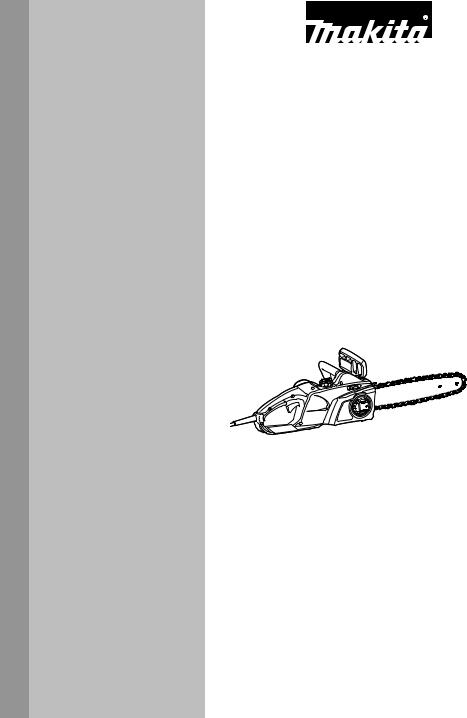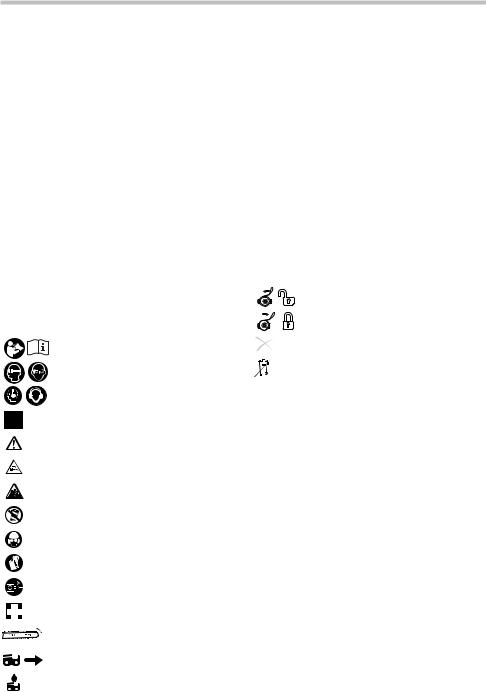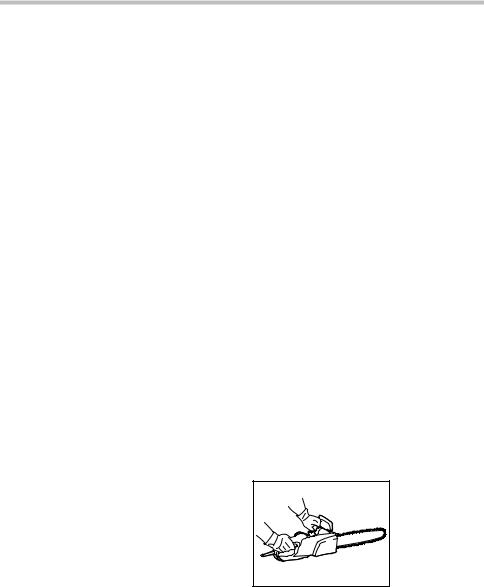Makita UC4041A, UC3541A, UC3041A User Manual

instructions) (Original ENGLISH
INSTRUCTION MANUAL
Electric Chain Saw
UC3041A
UC3541A
UC4041A
014315
 DOUBLE INSULATION
DOUBLE INSULATION
IMPORTANT: Read Before Using.

ENGLISH (Original instructions)
SPECIFICATIONS
|
Model |
UC3041A |
UC3541A |
UC4041A |
|||||||
Max. chain speed |
|
|
|
14.5 m/s (870 m/min) |
|
|
|
||||
|
|
Bar length |
300 mm |
350 mm |
400 mm |
||||||
Standard guide bar |
|
Cutting length |
265 mm |
325 mm |
360 mm |
||||||
|
|
Guide bar type |
|
|
|
Sprocket nose bar |
|
|
|
||
|
|
Type |
90PX |
|
91PX |
90PX |
|
91PX |
90PX |
|
91PX |
Standard saw chain |
|
Pitch |
|
|
|
|
3/8" |
|
|
|
|
|
|
No. of drive links |
|
46 |
|
52 |
56 |
|
|||
Recommended guide bar length |
|
|
|
300 - 400 mm |
|
|
|
||||
Overall length (without guide bar) |
|
|
|
455 mm |
|
|
|
||||
|
Net weight |
4.6 kg |
4.7 kg |
4.7 kg |
|||||||
Extension cable (optional) |
|
DIN 57282/HO 7RN -F L=30 m max.,3x1.5 mm2 |
|
||||||||
•Due to our continuing program of research and development, the specifications herein are subject to change without notice.
•Specifications may differ from country to country.
•Weight according to EPTA-Procedure 01/2003
END218-7
Symbol
The following show the symbols used for the equipment. Be sure that you understand their meaning before use.
Read instruction manual and follow the warnings and safety instructions.
Wear eye protection.
Wear ear protection.
DOUBLE INSULATION
Caution: particular care and attention
required!
Caution: withdraw the mains plug immediately if the cable is damaged!
Caution: kickback!
Protect against rain and damp!
Wear a helmet, goggles and ear protection!
Wear safety gloves!
Withdraw the mains plug!
First aid
Maximum permissible length of cut
Direction of chain travel
Chain oil
Chain brake released
Chain brake applied
Prohibited!
Only for EU countries
Do not dispose of electric equipment together with household waste material!
In observance of the European Directive, on Waste Electric and Electronic Equipment and its implementation in accordance with national law, electric equipment that have reached the end of their life must be collected separately and returned to an environmentally compatible recycling facility.
ENE085-1
Intended use
The tool is intended for cutting lumbers and logs.
ENF002-2
Power supply
The tool should be connected only to a power supply of the same voltage as indicated on the nameplate, and can only be operated on single-phase AC supply. They are double-insulated and can, therefore, also be used from sockets without earth wire.
ENF100-1
For public low-voltage distribution systems of between 220 V and 250 V.
Switching operations of electric apparatus cause voltage fluctuations. The operation of this device under unfavorable mains conditions can have adverse effects
2

to the operation of other equipment. With a mains impedance equal or less than 0.29 Ohms it can be presumed that there will be no negative effects. The mains socket used for this device must be protected with a fuse or protective circuit breaker having slow tripping characteristics.
ENG905-1
Noise
The typical A-weighted noise level determined according to EN60745:
Sound pressure level (LpA) : 90.3 dB (A)
Sound power level (LWA) : 101.3 dB (A)
Uncertainty (K) : 2.5 dB (A)
Wear ear protection
ENG900-1
Vibration
The vibration total value (tri-axial vector sum) determined according to EN60745:
Work mode : cutting wood Vibration emission (ah) : 4.7 m/s2 Uncertainty (K) : 1.5 m/s2
ENG901-1
•The declared vibration emission value has been measured in accordance with the standard test method and may be used for comparing one tool with another.
•The declared vibration emission value may also be used in a preliminary assessment of exposure.
 WARNING:
WARNING:
•The vibration emission during actual use of the power tool can differ from the declared emission value depending on the ways in which the tool is used.
•Be sure to identify safety measures to protect the operator that are based on an estimation of exposure in the actual conditions of use (taking account of all parts of the operating cycle such as the times when the tool is switched off and when it is running idle in addition to the trigger time).
ENH021-8
For European countries only
EC Declaration of Conformity
Makita declares that the following Machine(s):
Designation of Machine: Chain Saw
Model No./ Type: UC3041A, UC3541A, UC4041A Specifications: see "SPECIFICATIONS" table.
Conforms to the following European Directives:
2000/14/EC, 2006/42/EC
They are manufactured in accordance with the following Standard or standardized documents:
EN60745
The Technical file in accordance with 2006/42/EC is available from:
Makita, Jan-Baptist Vinkstraat 2, 3070, Belgium
The conformity assessment procedure required by Directive 2000/14/EC was in Accordance with annex V Measured Sound Power Level: 102.2 dB (A) Guaranteed Sound Power Level: 104 dB (A)
26.4.2013
000331
Yasushi Fukaya
Director
Makita, Jan-Baptist Vinkstraat 2, 3070, Belgium
GEA005-3
General Power Tool Safety Warnings
 WARNING Read all safety warnings and all instructions. Failure to follow the warnings and instructions may result in electric shock, fire and/or serious injury.
WARNING Read all safety warnings and all instructions. Failure to follow the warnings and instructions may result in electric shock, fire and/or serious injury.
Save all warnings and instructions for future reference.
The term "power tool" in the warnings refers to your mains-operated (corded) power tool or battery-operated (cordless) power tool.
Work area safety
1.Keep work area clean and well lit. Cluttered or dark areas invite accidents.
2.Do not operate power tools in explosive atmospheres, such as in the presence of flammable liquids, gases or dust. Power tools create sparks which may ignite the dust or fumes.
3

3.Keep children and bystanders away while 15. Do not overreach. Keep proper footing and
operating a power tool. Distractions can cause you to lose control.
Electrical safety
4.Power tool plugs must match the outlet. Never modify the plug in any way. Do not use any adapter plugs with earthed (grounded) power tools. Unmodified plugs and matching outlets will reduce risk of electric shock.
5.Avoid body contact with earthed or grounded surfaces such as pipes, radiators, ranges and refrigerators. There is an increased risk of electric shock if your body is earthed or grounded.
6.Do not expose power tools to rain or wet conditions. Water entering a power tool will increase the risk of electric shock.
balance at all times. This enables better control of the power tool in unexpected situations.
16.Dress properly. Do not wear loose clothing or jewellery. Keep your hair, clothing, and gloves away from moving parts. Loose clothes, jewellery or long hair can be caught in moving parts.
17.If devices are provided for the connection of dust extraction and collection facilities, ensure these are connected and properly used. Use of dust collection can reduce dust-related hazards.
Power tool use and care
18.Do not force the power tool. Use the correct power tool for your application. The correct power tool will do the job better and safer at the rate for which it was designed.
7.Do not abuse the cord. Never use the cord for 19. Do not use the power tool if the switch does
carrying, pulling or unplugging the power tool. Keep cord away from heat, oil, sharp edges or moving parts. Damaged or entangled cords increase the risk of electric shock.
8.When operating a power tool outdoors, use an extension cord suitable for outdoor use. Use of a cord suitable for outdoor use reduces the risk of electric shock.
9.If operating a power tool in a damp location is unavoidable, use a residual current device (RCD) protected supply. Use of an RCD reduces the risk of electric shock.
10.Use of power supply via a RCD with a rated residual current of 30mA or less is always
recommended. Personal safety
11.Stay alert, watch what you are doing and use common sense when operating a power tool. Do not use a power tool while you are tired or under the influence of drugs, alcohol or medication. A moment of inattention while operating power tools may result in serious personal injury.
not turn it on and off. Any power tool that cannot be controlled with the switch is dangerous and must be repaired.
20.Disconnect the plug from the power source and/or the battery pack from the power tool before making any adjustments, changing accessories, or storing power tools. Such preventive safety measures reduce the risk of starting the power tool accidentally.
21.Store idle power tools out of the reach of children and do not allow persons unfamiliar with the power tool or these instructions to operate the power tool. Power tools are dangerous in the hands of untrained users.
22.Maintain power tools. Check for misalignment or binding of moving parts, breakage of parts and any other condition that may affect the power tool’s operation. If damaged, have the power tool repaired before use. Many accidents are caused by poorly maintained power tools.
23.Keep cutting tools sharp and clean. Properly maintained cutting tools with sharp cutting edges are less likely to bind and are easier to control.
12.Use personal protective equipment. Always 24. Use the power tool, accessories and tool bits
wear eye protection. Protective equipment such as dust mask, non-skid safety shoes, hard hat, or hearing protection used for appropriate conditions will reduce personal injuries.
13.Prevent unintentional starting. Ensure the switch is in the off-position before connecting to power source and/or battery pack, picking up or carrying the tool. Carrying power tools with your finger on the switch or energising power tools that have the switch on invites accidents.
14.Remove any adjusting key or wrench before turning the power tool on. A wrench or a key left attached to a rotating part of the power tool may result in personal injury.
etc. in accordance with these instructions, taking into account the working conditions and the work to be performed. Use of the power tool for operations different from those intended could result in a hazardous situation.
Service
25.Have your power tool serviced by a qualified repair person using only identical replacement parts. This will ensure that the safety of the power tool is maintained.
26.Follow instruction for lubricating and changing accessories.
27.Keep handles dry, clean and free from oil and grease.
4

GEB037-8
Chain saw safety warnings
1.Keep all parts of the body away from the saw chain when the chain saw is operating. Before you start the chain saw, make sure the saw chain is not contacting anything. A moment of inattention while operating chain saws may cause entanglement of your clothing or body with the saw chain.
2.Always hold the chain saw with your right hand on the rear handle and your left hand on the front handle. Holding the chain saw with a reversed hand configuration increases the risk of personal injury and should never be done.
3.Hold the power tool by insulated gripping surfaces only, because the saw chain may contact hidden wiring or its own cord. Saw chains contacting a "live" wire may make exposed metal parts of the power tool "live" and could give the operator an electric shock.
4.Wear safety glasses and hearing protection. Further protective equipment for head, hands, legs and feet is recommended. Adequate protective clothing will reduce personal injury by flying debris or accidental contact with the saw chain.
5.Do not operate a chain saw in a tree. Operation of a chain saw while up in a tree may result in personal injury.
6.Always keep proper footing and operate the chain saw only when standing on fixed, secure and level surface. Slippery or unstable surfaces such as ladders may cause a loss of balance or control of the chain saw.
7.When cutting a limb that is under tension be alert for spring back. When the tension in the wood fibres is released the spring loaded limb may strike the operator and/or throw the chain saw out of control.
8.Use extreme caution when cutting brush and saplings. The slender material may catch the saw chain and be whipped toward you or pull you off balance.
9.Carry the chain saw by the front handle with the chain saw switched off and away from your body. When transporting or storing the chain saw always fit the guide bar cover.
Proper handling of the chain saw will reduce the likelihood of accidental contact with the moving saw chain.
10.Follow instructions for lubricating, chain tensioning and changing accessories.
Improperly tensioned or lubricated chain may either break or increase the chance for kickback.
11.Keep handles dry, clean, and free from oil and grease. Greasy, oily handles are slippery causing loss of control.
12.Cut wood only. Do not use chain saw for purposes not intended. For example: do not use chain saw for cutting plastic, masonry or non-wood building materials. Use of the chain saw for operations different than intended could result in a hazardous situation.
13.Causes and operator prevention of kickback:
Kickback may occur when the nose or tip of the guide bar touches an object, or when the wood closes in and pinches the saw chain in the cut.
Tip contact in some cases may cause a sudden reverse reaction, kicking the guide bar up and back towards the operator.
Pinching the saw chain along the top of the guide bar may push the guide bar rapidly back towards the operator.
Either of these reactions may cause you to lose control of the saw which could result in serious personal injury. Do not rely exclusively upon the safety devices built into your saw. As a chain saw user, you should take several steps to keep your cutting jobs free from accident or injury.
Kickback is the result of tool misuse and/or incorrect operating procedures or conditions and can be avoided by taking proper precautions as given below:
−Maintain a firm grip, with thumbs and fingers encircling the chain saw handles, with both hands on the saw and position your body and arm to allow you to resist kickback forces. Kickback forces can be controlled by the operator, if proper precautions are taken. Do not let go of the chain saw.
014316 |
−Do not overreach and do not cut above shoulder height. This helps prevent unintended tip contact and enables better control of the chain saw in unexpected situations.
−Only use replacement bars and chains specified by the manufacturer. Incorrect replacement bars and chains may cause chain breakage and/or kickback.
5

−Follow the manufacturer’s sharpening and maintenance instructions for the saw chain. Decreasing the depth gauge height can lead to increased kickback.
ADDITIONAL SAFETY RULES
1.Read the instruction manual in order to familiarize yourself with operation of the chain saw.
2.Before using the chain saw for the first time, arrange to have instruction in its operation. If this is not possible, at least practice cutting round timber on a trestle before beginning work.
3.The chain saw must not be used by children or young persons under 18 years of age. Young persons over 16 years of age may be exempted from this restriction if they are undergoing training under the supervision of an expert.
4.Working with the chain saw requires a high level of concentration. Do not work with the saw if you are not feeling fit and well. Carry out all work calmly and carefully.
5.Never work under the influence of alcohol, drugs or medication.
Proper use
1.The chain saw is intended solely for cutting wood. Do not use it for example to cut plastic or porous concrete.
2.Only use the chain saw for operations described in this instruction manual. Do not, for example, use it to trim hedges or for similar purposes.
3.The chain saw must not be used for forestry work, i.e. for felling and limbing standing timber. The chain saw cable does not provide the operator with the mobility and safety required for such work.
4.The chain saw is not intended for commercial use.
5.Do not overload the chain saw.
Personal protective equipment
1.Clothing must be close-fitting, but must not obstruct mobility.
2.Wear the following protective clothing during work:
•A tested safety helmet, if a hazard is presented by falling branches or similar;
•A face mask or goggles;
•Suitable ear protection (ear muffs, custom or mouldable ear plugs). Octave brand analysis upon request.
•Firm leather safety gloves;
•Long trousers manufactured from strong fabric;
•Protective dungarees of cut-resistant fabric;
•Safety shoes or boots with non-slip soles, steel toes, and cut-resistant fabric lining;
•A breathing mask, when carrying out work which produces dust (e.g. sawing dry wood).
Protection against electric shock
The chain saw must not be used in wet weather or damp environments, as the electric motor is not waterproof.
1.Only plug the saw into sockets in tested electrical circuits. Check that the system voltage matches that on the rating plate. Ensure that a 16 A line fuse is fitted. Saws used in the open air must be connected to a residual current-operated circuitbreaker with an operating current no higher than 30 mA.
Safe working practices
1.Before starting work, check that the chain saw is in proper working order and that its condition complies with the safety regulations. Check in particular that:
•The chain brake is working properly;
•The run-down brake is working properly;
•The bar and the sprocket cover are fitted correctly;
•The chain has been sharpened and tensioned in accordance with the regulations;
•The mains cable and mains plug are
undamaged;
Refer to the "CHECKS " section.
2.Always ensure in particular that the extension cable used is of adequate cross-section (see "SPECIFICATIONS"). When using a cable reel, wind the cable completely off the reel. When using the saw in the open air, ensure that the cable employed is intended for open-air use and is rated accordingly.
3.Keep the cord away from the cutting area and to position cord so that it will not be caught on branches, and the like, during cutting.
4.Do not operate the chain saw in the vicinity of flammable dust or gases, as the motor generates sparks and presents a risk of explosion.
5.Work only on firm ground and with a good footing. Pay particular attention to obstacles (e.g. the cable) in the working area. Take particular care where moisture, ice, snow, freshly cut wood or bark may make surfaces slippery. Do not stand on ladders or trees when using the saw.
6.Take particular care when working on sloping ground; rolling trunks and branches pose a potential hazard.
7.Never cut above shoulder height.
6
